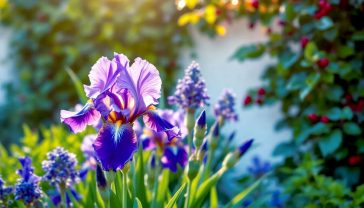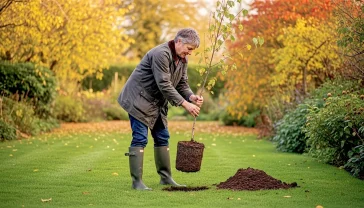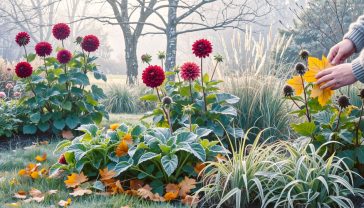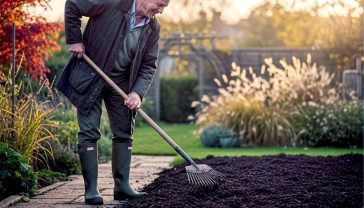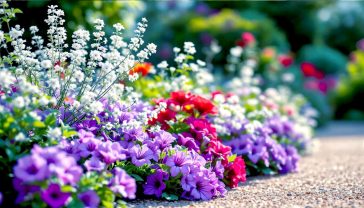Summer’s Sun: Navigating the Highs and Lows of Summer Gardening
The ultimate guide to navigating a British summer in the garden. From watering wisely and tackling pests to choosing the perfect plants for our climate.
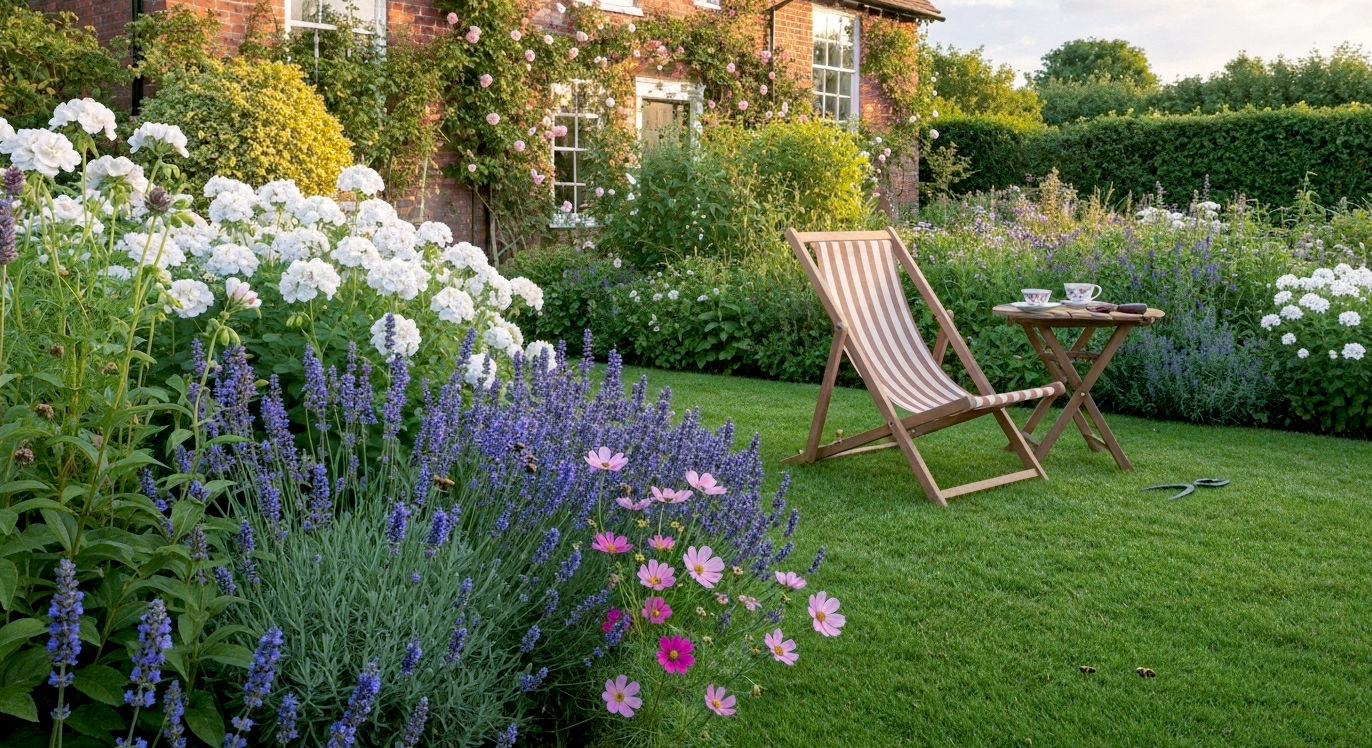
This post may contain affiliate links. If you make a purchase through these links, we may earn a commission at no additional cost to you.
Ah, summer. The season of long, lazy days, the drone of lawnmowers, and the scent of freshly cut grass. For British gardeners, it’s the moment we’ve all been waiting for. After months of nurturing seedlings on windowsills and hoping for the last frost to pass, summer is when our gardens should, in theory, burst into a riot of colour and life. It’s the grand finale, the peak of the gardening year when all our hard work pays off. But let’s be honest, it’s not always that simple, is it?
Summer gardening in Britain is a unique blend of triumph and trouble. One minute you’re basking in a heatwave, the next you’re dashing out in a downpour to rescue your petunias. It’s a season of glorious highs—the first homegrown tomato, a rose in full bloom, the buzz of happy bees—and frustrating lows, like an invasion of aphids or a sudden hosepipe ban. It’s a quintessentially British pastime, a delicate dance with our famously fickle weather.
This guide is your ultimate companion to navigating the rollercoaster of summer gardening. Whether you’ve got a sprawling country garden, a neat suburban plot, or a few pots on a city balcony, we’ll cover everything you need to know. We’ll dig into the jobs that keep your garden thriving, from watering wisely to deadheading like a pro. We’ll explore how to tackle the pests and problems that summer throws at us and look at the best plants to grow for a stunning display that lasts right through to autumn. Think of this as your friendly, down-to-earth chat over the garden fence, packed with tips, tricks, and a good dose of realism. So, grab a cuppa (or maybe a Pimm’s), pull up a deckchair, and let’s get our hands dirty.
The Heart of the Matter: Understanding the British Summer Garden
Before we roll up our sleeves, it’s worth taking a moment to appreciate what makes summer gardening in the UK so special—and so challenging. Unlike the predictable, scorching summers of the Mediterranean, a British summer is a beautiful mess of contradictions. We can have weeks of glorious sunshine that bake the soil, followed by thunderstorms that flatten our delphiniums. This unpredictability is the defining feature of our gardening experience.
Our Love Affair with the Garden
Gardening is etched into the British soul. It’s more than just a hobby; it’s a national obsession. From the grand, sweeping landscapes designed by Capability Brown in the 18th century to the humble, treasured allotments that fed the nation during the war, gardens are a cornerstone of our culture. They are our sanctuaries, a place to connect with nature, and a source of immense pride. The Chelsea Flower Show isn’t just a gardening event; it’s a major fixture in the national calendar, reported on the evening news.
This passion reaches fever pitch in summer. It’s the season of village fetes with ‘best rose’ competitions, of neighbours swapping courgettes over the fence, and of entire afternoons lost to the simple, satisfying task of weeding. Our gardens become outdoor living rooms, places for barbecues, children’s paddling pools, and quiet moments with a book.
The Great British Weather: A Gardener’s Best Friend and Worst Enemy
If there’s one topic that unites British gardeners, it’s the weather. It dictates everything we do. A heatwave means a frantic rush to water everything before it wilts, while a week of solid rain brings the fear of slugs and rot.
The Sunshine: When the sun does grace us with its presence, it transforms our gardens. Photosynthesis, the process where plants use sunlight to create food, goes into overdrive. This is what fuels the explosive growth of summer. Flowers bloom more vibrantly, vegetables ripen, and lawns turn a lush green (for a while, at least). The long daylight hours of June and July give plants plenty of time to soak up this energy.
The Rain: We might complain about it, but summer rain is a gardener’s lifeline. It saves us endless hours of watering and gives plants the deep, thorough drink they need to thrive. A good downpour helps wash dust off leaves, allowing them to breathe and photosynthesise more efficiently.
The Problem: The issue is the lack of balance. In recent years, our summers have become more extreme. We see prolonged dry spells followed by intense, flash-flooding downpours. This is tough on our gardens. Baked, compacted soil can’t absorb sudden, heavy rain, leading to runoff and wasted water. Plants get stressed by the seesaw between drought and deluge. This is the central challenge we’ll keep coming back to: how to build a resilient garden that can cope with whatever our climate throws at it.
The Summer Survival Toolkit: Essential Jobs for a Thriving Garden
Right, let’s get down to brass tacks. Keeping a garden looking its best in summer isn’t about grand, one-off projects. It’s about a series of small, regular tasks—a little and often approach. Get these right, and you’ll be well on your way to a summer of success.
Watering: The Golden Rules
It sounds simple, but how and when you water can make the difference between a garden that just about survives and one that truly flourishes.
When to Water?
The best time to water is early in the morning. The air is cool, so less water is lost to evaporation. This gives the plants a good supply of moisture to face the heat of the day. If you can’t manage the morning, the evening is the next best option. Avoid watering in the middle of a hot, sunny day. The water can evaporate before it even reaches the roots, and droplets on leaves can act like tiny magnifying glasses, potentially scorching them.
How to Water?
The mantra here is deeply and less frequently, rather than a light sprinkle every day. A quick splash only wets the surface of the soil, encouraging roots to stay shallow where they are more vulnerable to drying out. You want to encourage roots to grow deep down in search of water.
- For pots and containers: Water until you see it running out of the drainage holes at the bottom. This ensures the entire root ball is soaked. On very hot days, they might need watering twice a day.
- For borders and veg patches: Give them a really good, long soak once or twice a week, depending on the weather. Aim the water at the base of the plant, not the leaves. This helps prevent fungal diseases like mildew. A watering can is great for targeting specific plants, while a seep or leaky hose laid along a border is a brilliant, water-efficient way to deliver moisture directly to the soil.
Water-Wise Wisdom
With hosepipe bans becoming a regular feature of British summers, learning to conserve water is crucial.
- Install a water butt (or two!): Collecting rainwater is the single best thing you can do. It’s free, and plants prefer it to tap water as it’s slightly acidic and free from chlorine.
- Mulch, mulch, mulch: Applying a layer of organic matter—like garden compost, bark chips, or well-rotted manure—on top of your soil is a game-changer. This layer acts like a blanket, locking in moisture, suppressing weeds, and gradually improving the soil structure as it breaks down. Apply it in spring or early summer when the soil is already moist.
- Choose the right plants: We’ll talk more about this later, but opting for drought-tolerant plants in sunny, dry spots is the smartest move of all.
Feeding: Fueling the Growth
Summer is a hungry season for plants. They’re growing fast, producing flowers, and setting fruit, all of which uses a huge amount of energy. Giving them a bit of extra food will pay you back with healthier plants and better displays.
- Plants in pots and hanging baskets: These are the hungriest of all. The nutrients in the compost get used up quickly, so they need a regular feed. A liquid seaweed or general-purpose liquid fertiliser every couple of weeks is ideal.
- Flowering plants in borders: Things like roses, dahlias, and cosmos will benefit from a fortnightly feed to keep the blooms coming. A high-potash fertiliser (like a tomato feed) is perfect as potash encourages flower production.
- Fruiting vegetables: Tomatoes, cucumbers, courgettes, and peppers need a weekly feed with a high-potash fertiliser once they start to form fruit. This helps the fruits to swell and ripen.
Deadheading and Pruning: The Kindest Cut
This is perhaps the most satisfying summer job. Deadheading is simply the act of removing spent flowers. It might seem fussy, but it’s vital for two reasons. Firstly, it makes your plants look much tidier. Secondly, and more importantly, it tricks the plant into producing more flowers. A plant’s main goal in life is to produce seeds and reproduce. If you remove the old flower before it sets seed, the plant thinks, “Oops, I’d better have another go,” and sends up another flush of blooms.
Use your fingers to pinch off soft stems (like on petunias) or a pair of secateurs for tougher ones (like roses). It’s a job you can do for ten minutes every evening, and it makes a huge difference.
Summer is also the time for some light pruning.
- Wisteria: Give it a summer prune in July or August, cutting back the long, whippy green shoots to about five or six leaves. This encourages it to form flower buds for next year.
- Spring-flowering shrubs: Things like Forsythia and Weigela should be pruned straight after they’ve finished flowering. This gives them plenty of time to grow new stems that will carry next year’s display.
- Stone fruit trees: Plums, cherries, and apricots are best pruned in summer, as this reduces the risk of a nasty fungal disease called silver leaf.
Keeping the Lawn in Check
A lush green lawn is the classic backdrop to a British summer garden. Keeping it looking good involves a few key tasks.
- Mowing: In summer, you should raise the height of your mower blades slightly. Leaving the grass a little longer helps it to cope with dry spells. The longer blades shade the soil, reducing water evaporation and preventing weeds from taking hold. Try to mow at least once a week, but don’t feel you have to stick rigidly to a schedule. If it’s very dry, let it grow longer.
- Watering: It’s generally best not to water established lawns. They are incredibly resilient and will bounce back as soon as the autumn rains arrive. A brown lawn in August is a normal sight in many parts of the UK. Watering lawns uses a huge amount of water, and it’s the first thing to be restricted during a hosepipe ban. If you have a newly seeded or turfed lawn, that’s a different story—it will need regular watering to establish.
- Weeding and Feeding: A summer lawn feed can help keep the grass strong and healthy. If you have persistent weeds like dandelions, you can remove them with a weeding tool or treat them with a spot weedkiller.
The Veg Patch: Reaping the Rewards
Summer is when the vegetable garden really comes into its own. It’s a time of harvesting and successional sowing to keep the crops coming.
The Harvest
This is the best bit! The taste of a sun-warmed tomato picked straight from the vine is one of life’s great pleasures.
- Little and often: Keep picking your crops. For things like French beans, runner beans, courgettes, and salads, the more you pick, the more they’ll produce. If you leave a courgette to turn into a giant marrow, the plant will think its job is done and stop producing new ones.
- What to harvest when:
- June: Strawberries, lettuce, radishes, early potatoes, broad beans.
- July: Raspberries, courgettes, French beans, runner beans, peas, carrots, beetroot, the first tomatoes.
- August: The main tomato and cucumber harvest, sweetcorn, onions, garlic (once the tops have yellowed and fallen over).
Keep on Sowing
Don’t let empty spaces appear in your veg patch. As soon as you’ve harvested a crop, you can pop something else in. Summer is the perfect time for sowing fast-growing crops that will be ready in autumn.
- Salads: Sow a short row of lettuce, rocket, and radishes every few weeks for a continuous supply.
- French beans: You can sow dwarf French beans right up until the end of July for a late autumn crop.
- Carrots and beetroot: Sow these before mid-July.
- Spring onions: These can be sown throughout the summer.
- Winter greens: Late summer is the time to think ahead. Sow things like kale, chard, and winter lettuces that will keep you going through the colder months.
Rogues’ Gallery: Tackling Summer Pests and Diseases
Unfortunately, we’re not the only ones who enjoy the garden in summer. A whole host of pests and diseases are also rubbing their hands together. A healthy garden is your best defence—strong, well-watered plants are much better at shrugging off problems. But sometimes, you need to intervene.
The Usual Suspects: Common Pests
- Aphids (Greenfly and Blackfly): These tiny sap-sucking insects are the bane of many a gardener’s life. They love soft, new growth and can multiply at an alarming rate.
- The solution: You can often just squish them with your fingers or blast them off with a jet of water from a hose. Encourage natural predators like ladybirds and hoverflies by planting flowers they love (like marigolds and cosmos) and avoiding pesticides. If you have a heavy infestation, a soap-based spray can be effective.
- Slugs and Snails: Ah, the arch-nemesis. They come out in damp conditions and can munch their way through young plants overnight.
- The solution: There’s no single magic bullet. A combination of tactics is best. Go out on a ‘slug patrol’ on damp evenings to pick them off by hand. Use copper tape around your pots, as they don’t like to cross it. Wool pellets are a good barrier, as they irritate their foot. Encourage predators like thrushes, frogs, and hedgehogs into your garden. Beer traps (a jam jar sunk into the soil and filled with cheap beer) can also be very effective.
- Cabbage White Butterflies: The adult butterflies are lovely, but the caterpillars they produce can strip brassicas (cabbages, broccoli, kale) bare in days.
- The solution: The best defence is a physical barrier. Cover your brassicas with fine netting (supported on hoops so it doesn’t touch the leaves) as soon as you plant them out. This stops the butterflies from laying their eggs on the leaves in the first place.
Common Diseases
- Powdery Mildew: This is a fungal disease that looks like a white, dusty coating on leaves. It often affects courgettes, pumpkins, and some flowering plants, especially when the weather is dry but the air is humid.
- The solution: Ensure good air circulation around your plants—don’t plant them too close together. Water the soil, not the leaves. Remove affected leaves as soon as you see them to stop it from spreading.
- Blight: This is the dreaded disease that affects tomatoes and potatoes. It’s a fungal disease that spreads rapidly in warm, wet weather (typically from late July onwards). It causes brown patches on the leaves and stems, and the whole plant can collapse very quickly.
- The solution: There’s no cure for blight, so prevention is key. When watering, avoid splashing the leaves. Some varieties have better blight resistance, so it’s worth seeking those out. If you see signs of blight, remove and destroy the affected plants immediately to try and stop it from spreading. Don’t put them on the compost heap.
Planting for a Sizzling Summer: Star Plants for the British Garden
Choosing the right plants is half the battle. You want plants that can cope with our conditions and that provide a long season of interest. Here are some reliable stars for a classic British summer garden.
Annuals and Bedding Plants
These are the plants that give you an instant splash of colour. You plant them in late spring, and they flower their socks off all summer until the first frosts.
- Cosmos: Tall, elegant, and incredibly easy to grow from seed. Their feathery foliage and simple, daisy-like flowers in shades of pink, white, and purple are a magnet for bees.
- Nicotiana (Tobacco Plant): A must-have for summer evenings. The trumpet-shaped flowers release a beautiful, sweet fragrance as dusk falls.
- Verbena bonariensis: A modern garden classic. It has tall, wiry stems topped with clusters of tiny purple flowers. It’s brilliant for adding height and an airy feel to a border, and pollinators absolutely love it.
- Sunflowers: The ultimate symbol of summer. There are so many varieties to choose from, from giant ones to dwarf, multi-headed types that are great for pots.
Perennials: The Backbone of the Border
These are the plants that come back year after year. They form the structure of your borders and provide reliable colour.
- Geraniums (Cranesbills): Not to be confused with Pelargoniums (the bedding plants often called geraniums). Hardy geraniums are tough, reliable, and come in shades of blue, pink, and white. Many of them flower for months on end.
- Salvias: A huge family of plants that are brilliant for summer colour. Salvia nemorosa ‘Caradonna’ is a classic, with spikes of intense violet-blue flowers. They are very drought-tolerant once established.
- Roses: No British garden is complete without a rose. Whether you choose a classic, fragrant old rose, a disease-resistant modern shrub rose, or a rambling rose to cover a wall, it will be the star of the show in June and July.
- Rudbeckia fulgida ‘Goldsturm’: For late summer colour, this is unbeatable. Its cheerful, black-eyed, golden-yellow daisies will brighten up the garden right into October.
Plants for a Hot, Dry Spot
As our summers get hotter, creating pockets of drought-tolerant planting is a smart idea. These plants thrive on sun and don’t need much watering once they’re established.
- Lavender: The quintessential English garden plant. Its fragrant flowers are adored by bees, and its grey-green foliage is adapted to conserve water.
- Nepeta (Catmint): A fantastic alternative to lavender, especially if your soil is a bit heavier. It forms a soft mound of grey-green leaves, covered in spikes of lavender-blue flowers for months.
- Stipa gigantea (Golden Oats): A magnificent ornamental grass that forms a clump of evergreen leaves and sends up tall, shimmering flower heads that catch the light beautifully.
The Bigger Picture: Gardening for the Future
Our gardens are not isolated bubbles. They are part of a wider ecosystem, and the choices we make can have a real impact. Summer is a great time to think about how we can make our gardens more wildlife-friendly and sustainable.
Welcoming Wildlife
A garden buzzing with life is a healthy garden.
- Provide water: A simple bird bath or a shallow dish of water with some pebbles in it for insects to land on can be a lifesaver during a dry spell.
- Let a patch go wild: You don’t need to have a perfectly manicured garden. Leaving a small patch of lawn to grow long or a corner with some nettles will provide food and shelter for a huge range of creatures.
- Plant for pollinators: Choose a mix of flowers with different shapes and sizes to attract a wide variety of bees, butterflies, and hoverflies. Single-flowered varieties are generally better than double ones, as the pollen and nectar are easier for insects to access.
Peat-Free and Plastic-Free
The gardening industry is slowly changing, but we can help drive that change.
- Go peat-free: Peat bogs are vital carbon stores and precious habitats. There is no need to use peat in our gardens anymore. The quality of peat-free composts has improved dramatically, so always choose the peat-free option.
- Reduce plastic: Look for alternatives to plastic pots and seed trays. You can buy biodegradable pots, or reuse the plastic pots you already have for as long as possible. Many garden centres now offer a pot recycling service.
As Summer Fades: Looking Ahead to Autumn
As August draws to a close, you can feel a change in the air. The light softens, the evenings draw in, and the garden starts to take on a golden, autumnal glow. This is not the end of the gardening year, but a time of transition.
It’s a time to celebrate the successes of the season, to enjoy the last of the harvest, and to start planning for the year ahead. Collect seeds from your favourite flowers, order your spring bulbs, and take a moment to sit back and appreciate the space you’ve created. A garden is never finished; it’s a constantly evolving journey. And after the highs and lows of a British summer, you’ve earned a well-deserved rest.
Further Reading and Resources
For those looking to dig a little deeper, these are some of the most respected resources for British gardeners:
- Royal Horticultural Society (RHS): The ultimate authority on all things gardening in the UK. Their website is a treasure trove of expert advice. https://www.rhs.org.uk/
- BBC Gardeners’ World: The online home of the beloved TV programme. It’s packed with practical tips, videos, and timely advice from trusted experts like Monty Don. https://www.gardenersworld.com/
- The National Trust: As well as looking after historic houses, the National Trust manages some of the most beautiful and influential gardens in the country. Their site offers great inspiration. https://www.nationaltrust.org.uk/gardens-and-parks
- The Wildlife Trusts: An excellent resource for learning how to make your garden a haven for local wildlife. https://www.wildlifetrusts.org/

